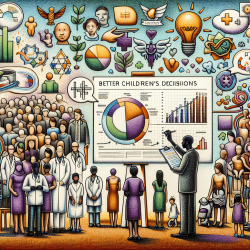Introduction
In the realm of speech-language pathology, understanding the genetic underpinnings of various disorders can significantly enhance therapeutic outcomes. The recent research article titled "GPAD: a natural language processing-based application to extract the gene-disease association discovery information from OMIM" offers a novel approach to this understanding. By employing natural language processing (NLP), GPAD provides a systematic method to extract and analyze gene-disease associations (GDAs) from the Online Mendelian Inheritance in Man (OMIM) database. This blog explores how practitioners can leverage GPAD to improve their skills and contribute to better outcomes for children.
Understanding GPAD
GPAD, or Gene-Phenotype Association Discovery, is an innovative tool that utilizes NLP to parse and synthesize data from OMIM. OMIM is a comprehensive database that catalogs Mendelian disorders and their associated genes. However, much of the information in OMIM is presented in a textual format, which can be challenging to navigate and interpret without automated tools. GPAD addresses this challenge by applying language-based techniques to extract relevant GDA information, such as the timing of associations and the validation methods used.
Implications for Practitioners
For practitioners in speech-language pathology, GPAD offers several benefits:
- Enhanced Understanding: By accessing up-to-date GDA information, practitioners can better understand the genetic factors influencing speech and language disorders, leading to more targeted interventions.
- Data-Driven Decisions: GPAD provides a data-driven approach to understanding trends in GDA discoveries, which can inform clinical decision-making and research priorities.
- Research Opportunities: The tool highlights areas where GDAs are under-researched, offering opportunities for practitioners to contribute to the field through further investigation and study.
Trends and Observations
GPAD has revealed several trends in GDA discoveries. Notably, there has been a significant increase in discoveries following the introduction of exome sequencing technologies. However, the rate of new discoveries has declined in recent years, likely due to the need for larger cohorts to substantiate associations. Additionally, the use of model organisms such as zebrafish and Drosophila has become more prevalent in providing evidential support for GDAs.
Conclusion
GPAD's real-time analyzing capacity offers a valuable tool for practitioners seeking to enhance their understanding of gene-disease associations. By leveraging this tool, speech-language pathologists can make more informed, data-driven decisions that ultimately lead to better outcomes for children. For those interested in further exploring this topic, I encourage you to read the original research paper, GPAD: a natural language processing-based application to extract the gene-disease association discovery information from OMIM.










